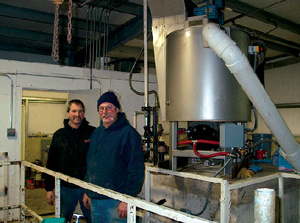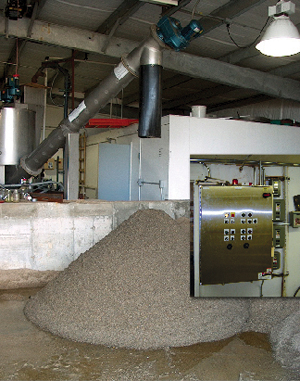
Wisconsin dairymen Brad and Jeff
Williams are achieving a 90 percent reclamation rate from recycling
their sand bedding with a system that includes a Parkson Tru-Grit
manure sand saver, the first of its size used in a dairy application.
 Jeff Williams (right) and Brad Williams have made the move back to sand, with a Parkson Tru-Grit manure sand separator. The brothers say they like the Tru-Grit unit because it is compact, yet still gets the job done without drawing a lot of horsepower. Jeff Williams (right) and Brad Williams have made the move back to sand, with a Parkson Tru-Grit manure sand separator. The brothers say they like the Tru-Grit unit because it is compact, yet still gets the job done without drawing a lot of horsepower. |
Wisconsin dairymen Brad and Jeff Williams are achieving a 90 percent reclamation rate from recycling their sand bedding with a system that includes a Parkson Tru-Grit manure sand saver, the first of its size used in a dairy application.
In the dairy business, it’s all about creating a contented cow to maximize production of high quality milk. An added bonus is if the dairy owner is equally contented. But that’s not always possible, being dependent on how onerous the manure management tasks are on a large herd.
The owners of Williams Bedrock Bovine Inc in Wisconsin—Brad and Jeff Williams—believe they are just one short step away from manure management contentment, having reverted back to using sand in their barn stalls after three years of agony using mattresses and wood shavings. Now, it is just a matter of perfecting their sand recycling system.
“We all know that sand is the Cadillac of cow comfort,” says Jeff, “but it’s a nightmare to work with. I think more and more manufacturers are starting to try to address the issue, as more dairymen want to go to sand—if they can find a way to move it.”
The Williams brothers operate their 700 milk cow, two-barn dairy about 40 miles south of Madison, and also plant about 1,700 acres of cropland, largely to produce feed for the herd. The business has grown significantly since the partnership began in 1984 with 45 milk cows. The first major expansion occurred in 2001 with a new barn capable of milking 300 cows, then a further expansion in 2004, with a 400-cow barn.
The herd generates between 9.5 and 10 million gallons of manure per year, not including wash water. Williams Bedrock Bovine started using sand with the construction of its first barn, hauling out the sand-laden manure for disposal every day. Shortly after, the dairy constructed an eight million-gallon capacity earthen lagoon, but experienced structural problems with it that required the installation of a plastic liner.
“By doing that, you can’t let sand get into the lagoon because you have no way to go in there and mechanically clean it out,” says Jeff. So that precipitated the switch to mattresses and wood shavings. “Our cull rate jumped from 25 percent to 45 percent and we had an unbelievable number of cows treated for mastitis. It was just a nightmare.”
They decided to build the second barn in 2004, but only if they could switch back to sand bedding. In the process of switching back, the Williams brothers did a lot of research.
“We visited numerous facilities to try to find a way to handle the sand-laden manure,” Jeff says. “There’s a lot of different ways out there. You kind of end up coming up with something on your own that should work, and hope to heck it does.”
Here’s a snapshot of the system that the Williams brothers designed, which allows them to reclaim over 90 percent of their bedding sand after each cleaning cycle. The entire system, including the building, cost them about $200,000. They expect the system to pay for itself in about two years for two reasons: They have reduced sand purchases by $60,000 per year and with a somatic cell count of less than 150,000 on a 700-head herd, they qualify for a significant quality premium on their milk. Their cull rate has also dropped to about 21 percent.
A constant theme throughout their manure management system is timing. In particular, regular agitation of the manure slurry in the manure collection pit is important, ensuring the sand stays in suspension. This is part of the challenge of achieving a high reclamation rate.
Sand selection is an important consideration right from the start. The coarser the sand, the better. By using fine particle sand, the dairy owner will likely only achieve 65 to 70 percent reclamation.
“What you actually do is create your own grade of sand over time,” says Jeff. As the sand circulates through the sand saver system, the fine grains wash out. “It took us four to six weeks to go from 65 percent reclamation to 90 percent. Now it is been 90 percent for over a year.”
After each milking shift, the dairy uses a skid steer to mechanically scrape the barn alleys, pushing the sand-laden manure into a central, three-foot-by-three-foot gutter. A mechanical scraper installed on a cable and connected to a timer, pushes the sand-laden manure from the gutter into a 16-foot by 16-foot, nine-foot deep collection and agitation pit.
“We have two Houle agitators in the pit that run for one minute every 12 minutes to keep the sand in suspension so that we can pump it to the separator,” says Jeff.
A six-inch inlet, equipped with a gate valve and a pump, connects the agitation pit to the adjacent dry pit and pumps the slurry over to the dry pit once it reaches a certain height in the agitation pit. From the dry pit, it is lifted into the Parkson Corporation, Model MSS, Tru-Grit manure sand separator. The frequency of the pumping action and operation of the sand separator is controlled by sonar sensors that detect the level of manure in the agitation pit.
The only glitch in the Williams’ current system is with the pump. “The separator has basically worked flawlessly,” says Jeff. “Our biggest nightmare is the squeeze pump. If there is going to be a problem, it is going to be that pump.”
The problem is that with more water being added to the slurry in the summer time (when the dairy is using sprinklers to keep its cows cool) and the fact that the agitators only run for 16 hours a day, the sand tends to settle out more in the collection pit. Sand has settled to the point where attempting to pump the collected sand has sometimes caused rips in the pump hose. It costs $1,200 to replace the hose each time it is damaged, and the dairy has replaced nine hoses in six months.
The Williams brothers believe they have found two pump styles that will solve their problem—either a Penn-Valley pump or a Houle piston pump.
The sand-laden manure enters the Tru-Grit manure sand separator through an opening at the top, while collected gray water from a holding tank is injected through nozzles at the bottom. The descending sand flows countercurrent to the rising water, initiating the first stage of sand cleaning. A bed of clean sand is gradually built up at the bottom of a collection tank. A stirring device moves slowly through the sand bed to loosen and dislodge the organic matter that is trapped in the sand. The rising flow of water moves the organics upward and out of the outflow, into an eight-inch PVC pipe, which discharges the water into a small settling pit.
“About 10 percent of the sand can’t be reclaimed because the particles are too fine,” says Jeff. “We have to keep that out of the lagoon. The sand settles out in this small settling pit. All the water and organics go over a weir wall and gravity flow into the lagoon.” About twice a week, they drive a skid steer into the settling pit and mechanically remove and dispose of the fine sand.
 Once clean sand is removed from the bottom of the collection tank by a shaftless spiral, it is placed in a pile on a sloped floor and the remaining water drains back into the agitation pit. It typically drains from one to three days. Once clean sand is removed from the bottom of the collection tank by a shaftless spiral, it is placed in a pile on a sloped floor and the remaining water drains back into the agitation pit. It typically drains from one to three days. |
The clean sand is removed from the bottom of the collection tank by a shaftless spiral. The spiral conveys the clean sand upward, rotating slowly and intermittently to encourage more drainage before discharge. The sand is dumped in a pile on a sloped floor, and remaining water drains back into the agitation pit. It typically drains from one to three days. The sand pile is mixed using a skid steer bucket and restacked a few times to also assist with drainage. Then it is reused in the dairy stalls as needed.
Williams says energy wise, the entire system is a very economical and efficient. There are 3/4 and 1/2 horsepower motors on the sand saver, each agitator operates on a 15 horsepower motor, and there is a 1/3 horsepower motor on the gutter scrapper.
Water consumption is a bigger issue. “Any system that washes sand is going to use water,” says Jeff. “We’re using 12 gallons of gray water for every 20 gallons of manure that’s processed. It sounds like a whole bunch of water, but it’s still less than anything else out there.”
Williams Bedrock Bovine chose the Tru-Grit manure sand saver because it is compact compared to other sand saver systems, yet still gets the job done without drawing a lot of horsepower. Jeff estimates that this model, which is the first one of its size being used in a dairy application, could handle the manure generated from up to 1,200 cows. Parkson Corporation produces a larger unit that is currently operating on a 3,600-head dairy in Michigan.
The Williams brothers contract the services of a custom manure applicator, equipped with a drag hose system, to inject the liquid manure from the lagoon on to their cropland twice a year. The liquid is pumped up to three miles away from the lagoon and then injected in the soil.
One added bonus to using sand for bedding instead of mattresses and wood shavings is that there are no wood shavings being transported to the lagoon as before. This gives the dairy more lagoon capacity, and the lagoon water has higher nutrient value because there is less filler going into it.
“Sand is golden,” says Jeff. “You just can’t get any better. Once we get our pump issues solved, life will be pretty darn good.”